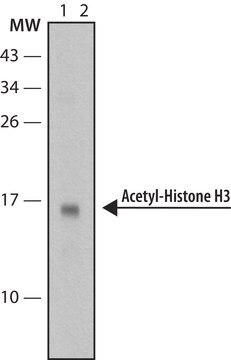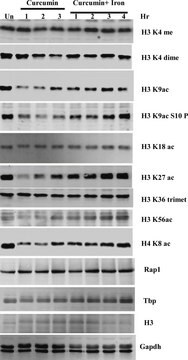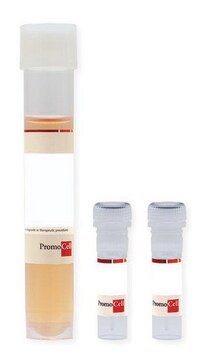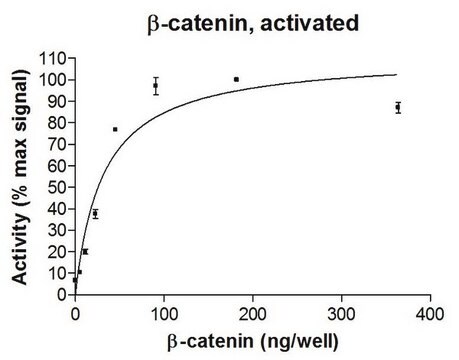04-790-S
Anti-dimethyl-Histone H3 (Lys4) Antibody, clone AW30, Trial Size
culture supernatant, clone AW30, Upstate®
Sinónimos:
H3K4me2, Histone H3 (di methyl K4)
About This Item
Productos recomendados
origen biológico
rabbit
Nivel de calidad
forma del anticuerpo
culture supernatant
tipo de anticuerpo
primary antibodies
clon
AW30, monoclonal
reactividad de especies
human, chicken
fabricante / nombre comercial
Upstate®
técnicas
ChIP: suitable (ChIP-seq)
dot blot: suitable
inhibition assay: suitable (peptide)
western blot: suitable
isotipo
IgG
Nº de acceso NCBI
Nº de acceso UniProt
Condiciones de envío
wet ice
modificación del objetivo postraduccional
dimethylation (Lys4)
Información sobre el gen
human ... H3C1(8350)
Descripción general
Especificidad
Inmunógeno
Aplicación
A 1:1000-1:2000 dilution of this lot detected dimethyl histone H3 (Lys4) in HeLa acid extracts.
Western Blot Analysis:
A 1:2,000 to 1:10,000 dilution of a previous lot detected methylated histone H3 in acid extracted proteins from HeLa cells. The antibody did not detect unmethylated recombinant Histone H3.
ChIP-seq Analysis:
Representative lot data. Chromatin immunoprecipitation was performed using the Magna ChIP HiSens kit (cat# 17-10460), Anti-dimethyl-Histone H3 (Lys4) antibody (2 µl cat# 04-790-S), 20 µL Protein A/G beads, and 1e6 crosslinked HeLa cell chromatin followed by DNA purification using magnetic beads. Libraries were prepared from Input and ChIP DNA samples using standard protocols with Illumina barcoded adapters, and analyzed on Illumina HiSeq instrument. An excess of sixteen million reads from FastQ files were mapped using Bowtie (http://bowtie-bio.sourceforge.net/manual.shtml) following TagDust (http://genome.gsc.riken.jp/osc/english/dataresource/) tag removal. Peaks were identified using MACS (http://luelab.dfci.harvard.edu/MACS/), with peaks and reads visualized as a custom track in UCSC Genome Browser (http://genome.ucsc.edu) from BigWig and BED files. The highest 25% of peaks identified in the 04-790 and 05-1338 datasets showed 92 and 90% overlap with peaks identified in the ENCODE H3K4me2 BROAD Histone track for HeLa S3.
Dot Blot Analysis:
Absurance Histone H3 Antibody Specificity Array (Cat. No. 16-667) and Absurance Histone H2A, H2B, H4 Antibody Specificity Array (Cat. No. 16-665), which contain histone peptides with various modifications were probed with Cat. No 04-790, Anti-dimethyl Histone H3 (Lys4), clone AW30 at 1:1000 dilution. Proteins were visualized using a Donkey anti-Rabbit IgG conjugated to HRP and a chemiluminescence detection system.
Peptide Inhibition Analysis:
2 μM of a histone H3 peptide containing dimethyl-lysine 4 abolished detection of histone H3 by a previous lot of antibody in immunoblot analysis of HeLa acid extracts. No signal reduction was observed with histone H3 peptides containing either monomethyl or trimethyl-lysine 4 modifications
Epigenetics & Nuclear Function
Histones
Calidad
Ligadura / enlace
Forma física
Almacenamiento y estabilidad
For maximum recovery of product, centrifuge the vial prior to removing the cap.
Nota de análisis
HeLa acid extracts
Información legal
Cláusula de descargo de responsabilidad
¿No encuentra el producto adecuado?
Pruebe nuestro Herramienta de selección de productos.
Código de clase de almacenamiento
12 - Non Combustible Liquids
Clase de riesgo para el agua (WGK)
WGK 1
Punto de inflamabilidad (°F)
Not applicable
Punto de inflamabilidad (°C)
Not applicable
Certificados de análisis (COA)
Busque Certificados de análisis (COA) introduciendo el número de lote del producto. Los números de lote se encuentran en la etiqueta del producto después de las palabras «Lot» o «Batch»
¿Ya tiene este producto?
Encuentre la documentación para los productos que ha comprado recientemente en la Biblioteca de documentos.
Nuestro equipo de científicos tiene experiencia en todas las áreas de investigación: Ciencias de la vida, Ciencia de los materiales, Síntesis química, Cromatografía, Analítica y muchas otras.
Póngase en contacto con el Servicio técnico








